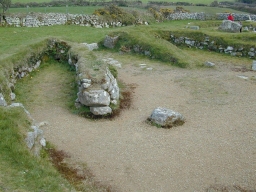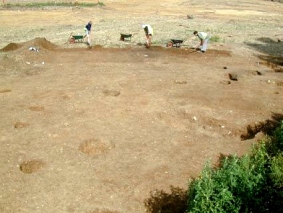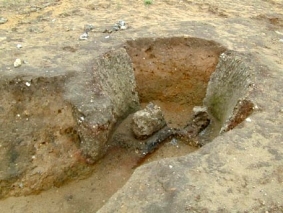Introduction to Archaeology
What is archaeology?

Archaeology is the study of people in the past based on their material remains. This means that most archaeologists look at the ruins and rubbish which people discarded, or the objects and people which they deliberately buried.
Archaeology is not about finding treasure, or about Indiana Jones or Lara Croft-style adventures! The discovery of information about people's lives in the past is much more rewarding and exciting to most professionals.
Archaeology, as studied today, is about the mundane and the everyday, although sometimes spectacular finds are made and it is these which capture the media's attention. Within the subject, it is not the objects which are important, but the information which they provide.
What is its relationship with history?
Most people think that archaeology is about history, but archaeologists are not historians. The basic difference lies in the type of evidence which the two disciplines use to interpret the past. Archaeologists use artefacts and stratigraphic evidence, whilst historians use documents. Both methods are equally valid and both have their advantages and disadvantages. Objects and holes in the ground can be difficult to relate to people's lives. Documents can be equally difficult to interpret as they cannot necessarily be taken at face value - the writers often lie, or exaggerate, or miss things out because they seem 'obvious'.
Archaeological evidence is particularly valuable in studying the lives of ordinary people, whilst documents tend to deal with the upper echelons of society. Both types of study may be appropriate in some cases, but to interpret archaeological remains solely on the basis of written evidence is not good practice. Neither is it acceptable to use selected archaeological evidence simply to illustrate history.
Archaeology in Britain today
Archaeological work in Britain is largely carried out by professional archaeological contractors who are required to 'clear' building sites of any archaeological remains as part of the planning process. This is known as 'rescue excavation'. Universities and amateur archaeological groups or individuals are more involved in 'research archaeology', and tend to excavate the same site over many seasons. Whilst the latter is the ideal, since it provides us with more detailed information about large areas of human activity, the former is inevitable where there is continuing development. Rescue archaeology has to be carried out efficiently, quickly and to budget so that development is not delayed and archaeological evidence is not lost. Whilst volunteers are often encouraged by contracting units, the slower pace of the research dig is often less stressful, more fun and better suited to inexperienced diggers.
Archaeological methods
The study of archaeology involves the use of a wide range of techniques, many of which have been borrowed from other disciplines. Excavation, the technique most widely associated with archaeology, is only one of many methods of studying the past. Before the archaeologist even puts a trowel to the ground, there are many ways of discovering the possible presence of archaeological material. These are called non-invasive techniques, as they do not involve the destruction of the site.
The main non-invasive techniques include:
- aerial photography - light and dark patterns in soils or crops may reveal sites
- desktop survey - known sites in the area are checked on the Sites and Monuments Record (SMR) or Historic Environment Record (HER)
- ground-penetrating radar, resistivity and magnetometer surveys - these and other techniques are used to 'see' patterns of low and high resistivity below the ground
- contour survey - to discover and plan earthworks
- physical survey - to record standing buildings or earthworks
- fieldwalking - to collect and plot artefacts and study their distribution patterns

Right: Flixton Quarry, Suffolk: cleaning the site
Excavation may also involve several stages and many different techniques. Often 'evaluation' is required to locate the most promising areas of a site to target during a full-scale excavation. Trenches or test-pits are dug in random or specific places, and the results of these mini-excavations are used to determine a project design for the second stage of digging.
Rescue excavations have to be finished as quickly as possible, so the topsoil and overburden is generally stripped using a mechanical excavator. On rural sites, the soil is taken off to the natural subsoil. Archaeological features usually show up very clearly as darker or lighter patches. Urban sites are more complex owing to the continued reuse of the land over many generations. The topsoil may still be stripped by machine, but hand-digging from much closer to the present-day land surface is desirable. After stripping, the site is cleaned using hoes or shovels to produce an even surface in which features can be seen. These are then hand-excavated using a combination of mattocks, shovels and trowels. Experience is the key to deciding which tool is the most appropriate for the job.

Left: Flixton Quarry, Suffolk: excavated Roman kiln with quarter-sections through lining and floor
The actual excavation technique chosen depends on the type of feature. Pits and postholes are usually half-sectioned, after which the remaining half is drawn and photographed. Ditches have several small trenches cut across them, and again their sections are drawn and recorded. Larger features, such as ovens or cellared buildings, may be quarter sectioned, with opposing quarters being removed first to leave a cross-section through both the length and the breadth of the feature. All features on the site are planned, and today this is often done using a digital positioning system which allows accurate computer plotting of sites. All excavated contexts and features are allocated individual numbers and recorded on context sheets.
The end of the excavation is not the end of the archaeologist's work on a site. Often the post-excavation part of the project is more involved and longer than the excavation itself. All site records are entered onto a computer database, and this is used as the basis of the site archive report. Features are described and groupings are considered. Artefacts are washed and quantified, before study by specialists. The dates provided by the specialists help to assign features to phases of human activity. The function of features and objects is a matter for interpretation, often based on similar findings at previously excavated sites, and then the activities carried out at the current site can be interpreted based on all the evidence. Finally, a full site report is produced, either as part of an in-house series or as a published document.
The publication of the raw data from a site allows future archaeologists to reinterpret earlier findings based on more recent research, so an archaeological site is never really finished.
Bibliography
Bahn, P., 1989, Bluff your way in Archaeology. Ravette Books, Horsham.
Barker, P., 1982, Techniques of Archaeological Excavation. 3rd edition. Batsford, London.
Carver, M., 1987, Underneath English Towns: interpreting urban archaeology. Batsford, London.